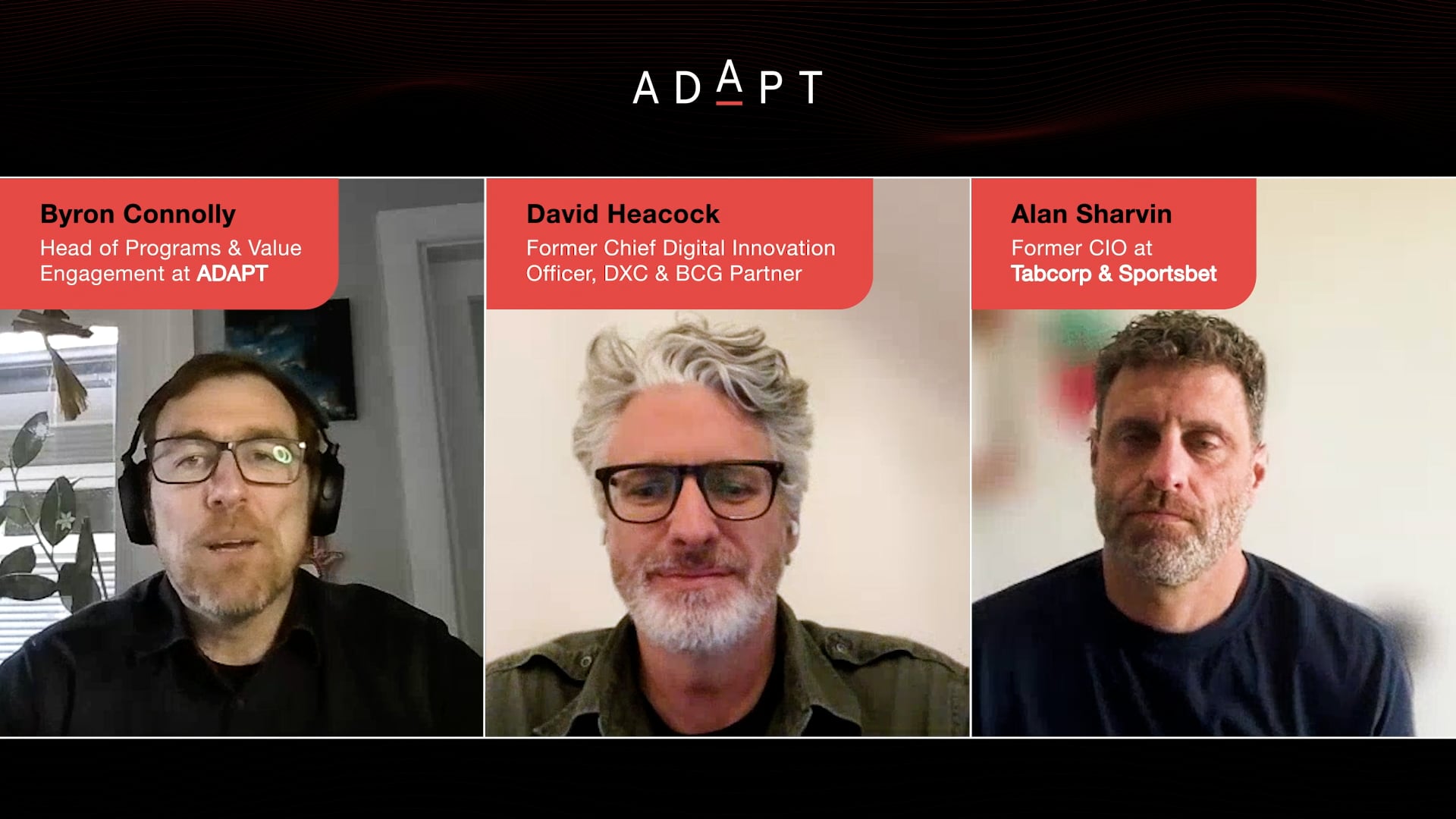The CIO-CEO Dilemma: Balancing Needs of Technology and Business
In today's digital age, the role of the CIO is more important than ever. As technology continues to evolve and play a more pervasive role in all aspects of business, the CIO must deeply understand the latest technologies and trends. The CIO must also be able to communicate complex technical concepts in a way that the CEO and other non-technical stakeholders can understand.
The CIO-CEO Dilemma: Balancing Needs of Technology and Business
For business continuity, consumers and employees rapidly adopted technology and the necessary procedural changes throughout the value chain during the COVID-19 era.
These changes have continued to create major business-model disruptions, which calls for CEOs to drive the tech agenda as much as they navigate the finance and corporate strategy.
Previously, CIOs were seen as IT service providers, limited to a support role to the business strategy. However, the recent changes in value delivery call for technology-led business strategies and have positioned the CIO as a strategic partner to the CEO.
CIOs have become guardians against margin risk, enablers of new products, services, and ways of working, and drivers of online collaboration.
Gone are the days when top business leaders would delegate technology and IT initiatives to their specialists. The highest corporate levels must now encompass technological investments in strategic planning.
An overview of the CEO and CIO roles
The CEO and CIO are two critical roles in any organisation, but they have very different responsibilities. The CEO oversees all the organisation’s operations, including IT. The CEO reports to the stockholders and is responsible for finance and profitability. The public image of an organisation is also often associated with the CEO.
In comparison, the CIO works behind the scenes. The CIO oversees the company’s web image, internal devices, systems, and applications. The CIOs have the most access to all the information the CEO needs. The CIO oversees the technology strategy and implementation of the organisation. CIOs are responsible for the technology infrastructure, information security, and the IT team.
The CEO and CIO are two critical roles that work together to ensure the success of an organisation. The CEO sets the direction and vision for the organisation, while the CIO ensures that the technology infrastructure is aligned with the overall strategy and goals of the organisation. The CIO acts as the bridge between the business and technology, providing the CEO with the information and insight needed to make strategic decisions.
In today’s digital age, the role of the CIO is more important than ever. As technology continues to evolve and play a more pervasive role in all aspects of business, the CIO must deeply understand the latest technologies and trends. The CIO must also be able to communicate complex technical concepts in a way that the CEO and other non-technical stakeholders can understand.

What’s causing barriers between CEOs and CIOs?
The relationship between the CEO and CIO is critical for the success of any organisation. However, there are often barriers that can prevent effective communication and collaboration between these two key roles.
One of the biggest barriers is a lack of understanding of technology on the part of the CEO. Many CEOs gained business experience before technology became as vital and complex as it is today. They may have yet to brush up on their computing skills, which can make it difficult for them to understand the direction and priorities of the IT department. This can lead to a lack of trust and even intimidation on the part of the CEO towards the CIO and their team.
Another barrier is a lack of alignment between the CEO’s and the CIO’s goals. The CEO is focused on driving business growth and profitability. In contrast, the CIO is focused on ensuring the technology infrastructure is aligned with the overall strategy and goals of the organisation. If these two roles are aligned, it can lead to clarity and conflicting priorities, hindering communication and collaboration.
The CEO and CIO must clearly understand each other’s roles and priorities to overcome these barriers. The CEO should take the time to learn about the latest technologies and trends and understand the direction and priorities of the IT department. The CIO, on the other hand, should make an effort to communicate complex technical concepts in a way that the CEO and other non-technical stakeholders can understand.
It is vital for both the CEO and CIO to work together to align their goals and objectives. This can be achieved through regular communication, collaboration, and using standard metrics to measure success.
Integration between the CEO and CIO
Traditionally, the role of the CIO has been limited to the IT department rather than being integrated into the overall business strategy. However, this is no longer the case in today’s digital age. The integration of the CEO and CIO is critical for the success of any organisation.
While the CEO is responsible for setting the overall direction and vision for the organisation, the CIO is responsible for ensuring the technology infrastructure is aligned with the overall strategy and goals of the organisation. The CIO is the technology expert and can provide valuable insights into how technology can be used to achieve the business goals set by the CEO.
Digital transformation is a crucial driver of business growth and profitability. However, it requires a company-wide culture shift from board members to employees. The CEO must be able to sell the tech innovation missions and investments to all stakeholders to bring about the needed change. And while the CEO is responsible for driving digital transformation efforts, the CIO is essential in providing the technical expertise necessary to implement new technologies and processes.
Given the alignment of their goals and how they complement each other’s roles, the CIO deserves a place alongside the CEO and other top executives in the boardroom to provide insight into every company decision.
The CIO can provide valuable insights into the potential impact of technology on the business, timelines for implementation, and potential return on investment.
To ensure that the integration between the CEO and CIO is successful, IT leaders must help CEOs and board members understand how technology can drive organisational value.
At CIO Edge, Atlassian’s Co-Founder, Scott Farquhar shared his belief that CIOs will naturally assume the CEO role in the near future.

Shared interests between CEOs and CIOs
Working with the CIO helps the CEO make better decisions while securing the organisation’s future. It is a collaboration in constant motion, and there are many ways CEOs and CIOs can work together:
Building the case for modernisation
The digital landscape is constantly evolving, and organisations are under pressure to modernise their IT infrastructure to keep up with changing consumer demands.
According to an ADAPT CIO survey, approximately 56% of Australian organisations have modernised their IT infrastructure. This is a significant increase from previous years, a trend that is expected to continue in the future.
One of the key benefits of modernising IT infrastructure is the ability to take advantage of the public cloud. Highly modernised organisations have 67% of their workloads in the public cloud, an ideal platform for building flexible and resilient architectures. The public cloud allows organisations to scale their resources as needed, and it also provides a level of redundancy that is not possible with traditional on-premise infrastructure.
Another benefit of modernising IT infrastructure is capturing more value from operations. Highly digitised organisations can capture more value from their operations, which helps them to stay competitive in the market. This can be achieved with automation and other technologies that improve efficiency and reduce costs.
However, modernising IT infrastructure is not an easy task. CIOs must be able to lead IT improvements that transform the business, work with front-end teams, and secure funding. The CEO must also support the CIO by convincing stakeholders to rethink the organisation’s legacy environment and ultimately build technological assets to keep up with consumer demands.
Advocating for emerging tech
In uncertain times, organisations tend to revert to familiar models and processes and put innovation projects on hold. However, this approach can be detrimental to the organisation’s long-term success. CIOs are critical in advocating for emerging technologies and driving innovation within the organisation.
CIOs are the board’s strategic partners and are best positioned to demystify IT concepts and help the organisation navigate risk, resiliency, and societal impact. They deeply understand the latest technologies and can provide valuable insights into how they can drive business growth and profitability.
To successfully advocate for emerging technologies, CIOs must demonstrate the business value, business case, and cost-benefits of technical investments. They must communicate complex technical concepts in a way that is easy for non-technical stakeholders to understand. By doing so, they can build support for new technologies and initiatives within the organisation.
Emerging technologies like on-demand access and technology-enabled autonomy for the workforce can provide a competitive advantage for the organisation. These technologies can help organisations to become more agile and responsive to changing market conditions. They also enable new business models to thrive, increasing revenue and profitability.
Leading the cultural shift
Modern technologies require a change in behaviour amongst an organisation’s workforce. In the digital age, employees must connect, collaborate and upskill more than ever. However, an organisation lacking a digital culture can prevent the CIO from gaining support for necessary digital initiatives.
Leaders, including the CIO, could shape culture and promote stakeholder engagement. By modelling self-awareness and sharing lessons from their failures, leaders can set an example for their team. Additionally, engaging staff in candid conversations to identify gaps and problem areas can help to identify areas that need improvement.
One of the most effective ways to lead a cultural shift is to demonstrate the behaviours that you want your team to emulate, which can include:
- Being a role model for the digital culture that you want to create
- Encouraging the use of technology in day-to-day activities, promoting collaboration and teamwork, and being open to new ideas and approaches
- Providing the necessary resources and support for employees to upskill and adapt to new technologies, such as training and development opportunities and access to the latest tools and technologies.
Instilling technical literacy amongst the workforce
Instilling technical literacy amongst the workforce is essential for organisations to leverage modern technologies’ benefits fully. Cutting-edge tools and the most advanced innovations can only succeed if the organisation considers human values. Strategies not driven by a desire to improve the human experience inhibit business transformation.
CIOs who successfully lead transformation actively consider available human talent in how the organisation designs and uses technologies. They understand that the success of any technology initiative is highly dependent on the ability of the workforce to use and adopt it. As such, they make a case to the board for aggressive efforts to empower staff through technical literacy.
The CEO also plays a critical role in this process by recognising the value of upskilling the workforce. Investing in technical literacy improves the human experience and directly impacts the bottom line. By upskilling the workforce, the need to hire and onboard outside tech talent for upcoming initiatives is reduced, resulting in cost savings for the organisation.
Creating an attractive environment for tech talent
Creating an attractive environment for tech talent is essential for organisations to stay competitive in the digital age. Digital businesses need top engineers to execute critical initiatives, yet boards tend to focus on hiring at the C-suite and senior-managerial levels.
Tech initiatives take much work, which requires a critical mass of talent that will only be achieved by just hiring a handful of people and waiting for the magic to happen.
Organisational inertia frustrates top talent, causing them to either leave the organisation or adapt to the legacy system and bureaucracy. This can lead to a talent drain and hinder the organisation’s ability to execute on critical initiatives.
CEOs and the board can take several steps to create an attractive environment for tech talent. Firstly, they can enable the use of new platforms where HR can advertise and find talent. This helps to attract a wider pool of candidates with diverse skill sets.
Secondly, they can support a culture where top engineers have the freedom to innovate. This can be achieved by reducing managerial oversight and providing opportunities for flexible career paths and upskilling.
Thirdly, they can prioritise and fund technology initiatives. This helps attract top talent and demonstrates the organisation’s commitment to innovation and technology.
Lastly, they can support fair compensation. This includes providing competitive salaries, benefits packages, and opportunities for bonuses and stock options.
Selling the vision to stakeholders.
Selling the vision to stakeholders is a crucial step in any change effort. The CEO often must decide how to communicate the change to the board and the staff. To effectively sell the vision to stakeholders, there are a few critical considerations for the CEO to keep in mind.
Firstly, the CEO must win over influencers within and outside the organisation. These individuals can play a critical role in helping to communicate the change to others and building support for the effort.
The CEO should identify key influencers and work to build relationships with them, ensuring they understand the vision and are on board with the change.
Secondly, it’s essential to have a steady cadence of the mission with succinct and direct messaging.
This helps ensure stakeholders receive consistent and clear information about the change effort. The CEO should be able to communicate the vision and its benefits clearly and concisely to stakeholders and do so in a way that is easy to understand.
The CEO should be able to clearly articulate the potential risks and challenges that the initiative could face and how they plan to mitigate them. This will help to build trust and credibility with stakeholders.
The bottom line
The past three years of disruption have led to a rapid shift in how businesses operate in Australia, with consumers and employees quickly adapting to new technologies and procedures to maintain continuity.
This has resulted in significant disruptions to traditional business models, requiring CEOs to take a more active role in shaping technology strategies in addition to their responsibilities in finance and corporate strategy.
In the past, CIOs were primarily seen as IT service providers with a limited role in shaping business strategies. However, the changes in value delivery brought about by the pandemic have expanded the role of the CIO in Australia, positioning them as strategic partners to the CEO.
CIOs are now responsible for a wide range of tasks, including protecting against margin risk, enabling new products and services, and promoting online collaboration.
Effective collaboration between the CEO and CIO is crucial for the success of an organisation in Australia. The CEO sets the direction and vision for the organisation, while the CIO ensures that the technology infrastructure aligns with these goals.
However, a lack of alignment between the CEO’s and the CIO’s purposes can lead to confusion and conflicting priorities, hindering communication and collaboration.
According to ADAPT’s 2022 study of Australian CIOs, conflicting business priorities are the top internal barrier to delivering on IT projects.
The CIO brings valuable expertise in technology and can provide insights to the CEO on how technology can be leveraged to achieve business goals.
CEOs and CIOs in Australia need to communicate and regularly collaborate to ensure that the organisation’s technology infrastructure is secure and can support the CEO’s vision for the future.
This includes discussing the impact of new technologies on the organisation, identifying areas for improvement, and developing strategies to optimise the use of technology to drive business growth and profitability.
























